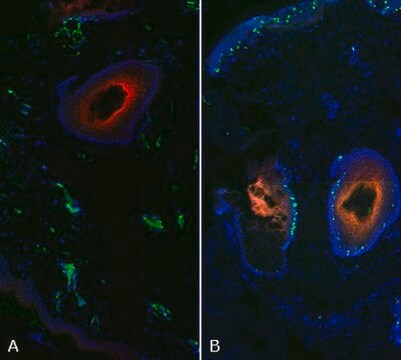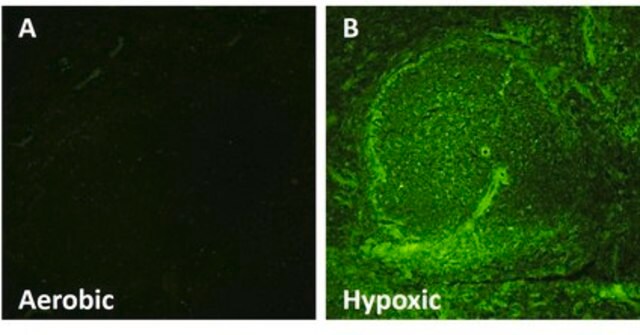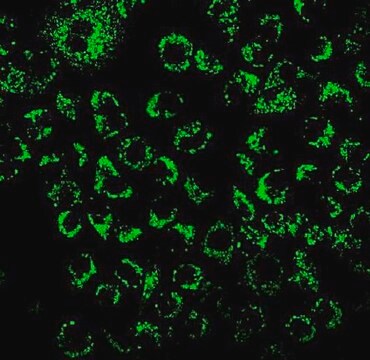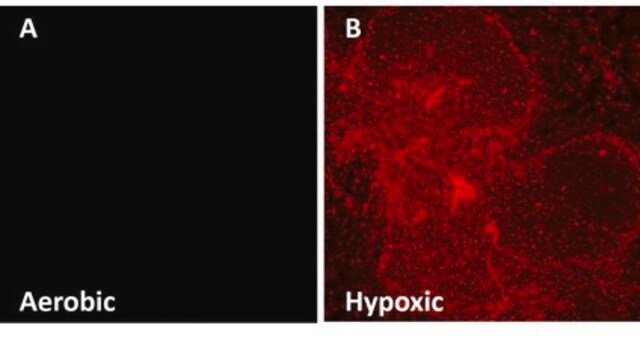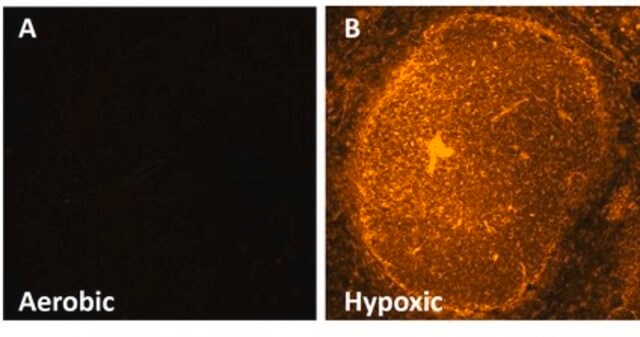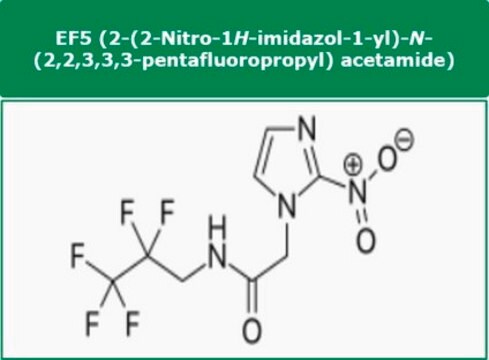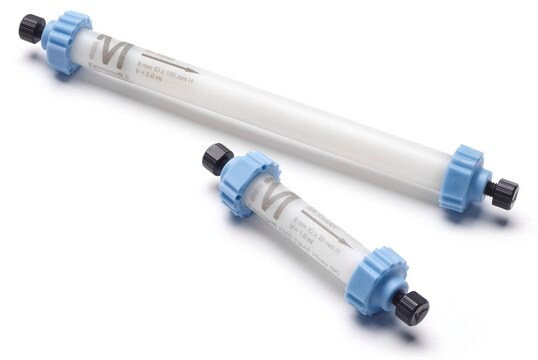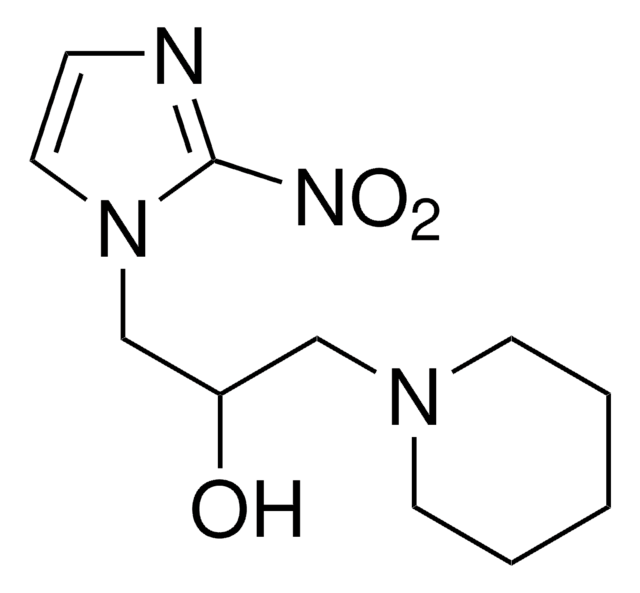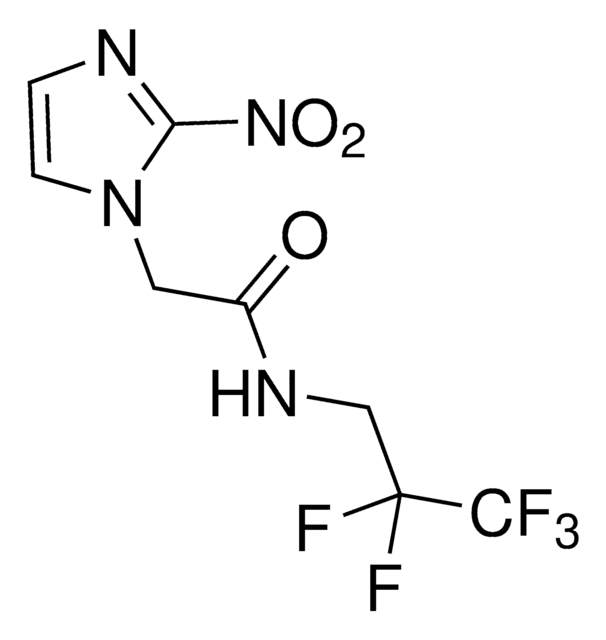EF5-30C3M
EF5 Hypoxia Detection Kit, Cyanine 3
Synonyme(s) :
Antibody-based EF5 detection
Se connecterpour consulter vos tarifs contractuels et ceux de votre entreprise/organisme
About This Item
Code UNSPSC :
12352207
eCl@ss :
32161000
Nomenclature NACRES :
NA.32
Produits recommandés
Technique(s)
immunofluorescence: suitable
immunohistochemistry: suitable
Niveau de qualité
Méthode de détection
fluorometric
Description générale
A number of imaging markers which target hypoxia exist and are widely used in research. EF5 is a compound developed at the University of Pennsylvania by Dr. Cameron Koch and Dr. Sydney Evans. Upon injection into animal tissues, EF5 selectively binds to hypoxic cells and forms adducts. A mouse monoclonal antibody, clone ELK3-51 which is directly conjugated to Cyanine 3 is then used to selectively bind the EF5 adducts.
Advantages of the EF5 Hypoxia Detection Kit:
• EF5 exists in only one form:
Pimidozole, an alternative hypoxia marker, exists in two forms; one of which is charged and very hydrophilic, the other lipophilic. Pimidozole thus has a very complex biodistribution. In contrast, EF5 is lipophilic and uncharged and this allows very rapid and even tissue distribution.
• EF5 binding images can be calibrated to provide quantitative data on the pO2 values of each cell (Koch CJ, 2002):
The fluorescent images obtained from EF5 binding can be calibrated according to camera settings and a “cube-binding” value which is obtained through a separate procedure. The intensity values of calibrated images are directly related to actual tissue pO2 values. As a result, these images provide information regarding not only where hypoxic areas may or may not be, but also data regarding the distribution and levels of hypoxia.
Reference:
Koch CJ (2002) Measurement of absolute oxygen levels in cells and tissues using oxygen sensors and 2-nitroimidazole EF5. Methods in Enzymology 352: 3-31.
Advantages of the EF5 Hypoxia Detection Kit:
• EF5 exists in only one form:
Pimidozole, an alternative hypoxia marker, exists in two forms; one of which is charged and very hydrophilic, the other lipophilic. Pimidozole thus has a very complex biodistribution. In contrast, EF5 is lipophilic and uncharged and this allows very rapid and even tissue distribution.
• EF5 binding images can be calibrated to provide quantitative data on the pO2 values of each cell (Koch CJ, 2002):
The fluorescent images obtained from EF5 binding can be calibrated according to camera settings and a “cube-binding” value which is obtained through a separate procedure. The intensity values of calibrated images are directly related to actual tissue pO2 values. As a result, these images provide information regarding not only where hypoxic areas may or may not be, but also data regarding the distribution and levels of hypoxia.
Reference:
Koch CJ (2002) Measurement of absolute oxygen levels in cells and tissues using oxygen sensors and 2-nitroimidazole EF5. Methods in Enzymology 352: 3-31.
Application
Antibody is provided in a concentrated format at 2 mg/mL. For optimal performance, antibody should be diluted to a working concentration of at least 75 ug/mL. Refer to product datasheet for details.
Research Category
Cancer
Cancer
The EF5 Hypoxia Detection Kit provides a sensitive and quantitative method to detect and measure tissue hypoxia in animal and human tumors, normal tissues and cells.
Composants
EF5 Compound, CAS 152721-37-4: (Part No. CS222743). 1 vial containing 30 mg. Store at -20°C.
Anti-EF5, clone ELK3-51 Cyanine 3 conjugate, 250 ug: (Part No. CS222730). 1 vial containing 125 uL mouse monoclonal antibody, provided at 2 mg/mL and formulated in PBS, 0.1% sodium azide, 30% glycerol and 1.5% BSA. Store at -20°C.
Anti-EF5, clone ELK3-51 Cyanine 3 conjugate, 250 ug: (Part No. CS222730). 1 vial containing 125 uL mouse monoclonal antibody, provided at 2 mg/mL and formulated in PBS, 0.1% sodium azide, 30% glycerol and 1.5% BSA. Store at -20°C.
Stockage et stabilité
Store kit at -20°C.
Clause de non-responsabilité
Unless otherwise stated in our catalog or other company documentation accompanying the product(s), our products are intended for research use only and are not to be used for any other purpose, which includes but is not limited to, unauthorized commercial uses, in vitro diagnostic uses, ex vivo or in vivo therapeutic uses or any type of consumption or application to humans or animals.
Code de la classe de stockage
10 - Combustible liquids
Certificats d'analyse (COA)
Recherchez un Certificats d'analyse (COA) en saisissant le numéro de lot du produit. Les numéros de lot figurent sur l'étiquette du produit après les mots "Lot" ou "Batch".
Déjà en possession de ce produit ?
Retrouvez la documentation relative aux produits que vous avez récemment achetés dans la Bibliothèque de documents.
Notre équipe de scientifiques dispose d'une expérience dans tous les secteurs de la recherche, notamment en sciences de la vie, science des matériaux, synthèse chimique, chromatographie, analyse et dans de nombreux autres domaines..
Contacter notre Service technique